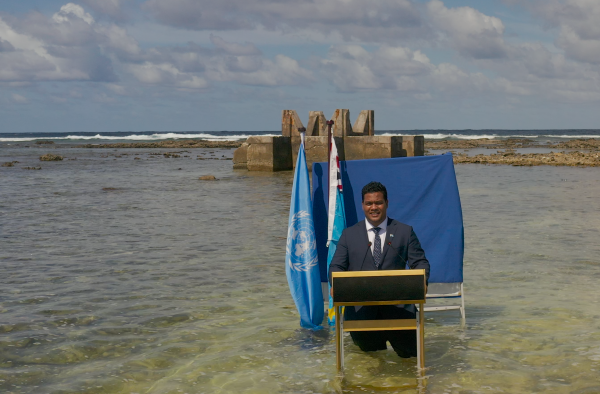Note: This is the first part of the two-article series on the dangers faced by Tuvalu. It is unfortunate that Asia’s tiny islands are hardly part of global discussions on climate change. It shall be our endeavor to sensitize our readership about all developments in Asia irrespective of their significance in the global media narratives. We will ensure that even Asia’s micro-minorities must receive the coverage they deserve.
Introduction
Climate change is a subject which is somewhat of an enduring issue, persisting through generations, occasionally garnering mass attention. It refers to the long-term shifts in temperatures and weather patterns may it be natural, such as through variations in the solar cycle, or manmade like the emissions of greenhouse gases through fossil fuels. However, many think of rising temperatures as the main issue for climate change but in reality, the rising temperature is merely the surface as the effects influence other areas before we really feel the effect of the physical heat. As climate change is one of the most pressing issues, tackling it is not the responsibility of a single country or government, but instead requires all nations of the world, multilateral organizations as well as the general public to devote honest and timely collective global actions. Yet, despite the efforts we as humans have been trying to implement, some successful and others not so much, the effects from the climate crisis are being felt all over the world from vital glaciers shrinking, longer and more intense heat waves, accelerated sea level rise, and coral bleaching just to name a few. But where does our world feel the effect of the climate emergency first? In most cases, unfortunately, the effects are felt by the geographically isolated and small land masses, situated on the outskirts of the world, bearing weak economies, with their total land mass barely surpassing that of a city on the mainland continents – the island nations of the Asia Pacific Ocean.
“We are now living the climate change in Tuvalu, we are seeing land fast disappearing.” – Seve Paeniu, 2021
Many know of the pristine white beaches and crystal clear turquoise waters of islands in the Asia Pacific, coupled with a care-free attitude that accompanies the stereotype of a small tropical island. However, it is these islands and their populations which are the first to feel the impact of rising sea levels due to climate change. These islands are more vulnerable to the acute effects of changes in the climate than any other region in the world, as they are barely a few meters above sea level to begin with, giving them little to no leeway to protect themselves.
The image of “sinking islands” has become a popular way to initiate discussions in both the academic and policy realms about the displacement of populations due to climate change. However, as seen in many other cases, small nations with little economic and political power are often over looked and forgotten in dialogue. With a limited natural resources and land area, the fragile environments of many of the small island nations offer less in terms of space for adaption than those of larger nations. This means that not only are the island nations the first ones to feel the consequences of climate change, but also typically do not have a large voice to convey the problem to the rest of the world, more often than not overshadowed by other events occurring in countries that bare more “importance”. Understanding and discussing the problems of the generally forgotten island nations is necessary to provide adequate strategies for the consequences that are to come if the climate crisis is not tackled in time in order to save the small strips of land, far away from the minds of the everyday person.
Tuvalu: Palm trees, idyllic waters, and imminent doom
A thin white smile curving across the blank face of the Asia Pacific Ocean, Tuvalu, made up of nine tiny coral atolls, sits on the outskirts of Australia in the endless blue open ocean. Being the fourth smallest nation in the world, the tiny island country is home to only 11,000 inhabitants most of which reside on the largest island of Fongafale. It has a total land area of less than 26 square kilometers which is juxtaposed against the 27 million kilometers square area of the Pacific Ocean surrounding it. But, not only is Tuvalu small in landmass and population, but also in level above the sea, reaching no more than four meters at its highest altitude.
Besides the fact that Tuvalu extremely limited geographically, it is a nation that is also sparse in resources. The United Nations Development Programme classifies Tuvalu and a resource poor, “least-developed country” that is “extremely vulnerable” to the effects of climate change. Not only is this due to the simple fact that the island will sink, but even before that, the population will suffer before the ocean has the chance to swallow it. This is because Tuvalu, like many other island nations, has an economy that is environmentally-based where the majority of its population is involved in sustenance farming and agriculture meaning that the sea is the basis of people’s lives. Therefore, when changes to the ocean occur, one of the first consequences is the destruction of their source of capital and sustenance. Furthermore, Tuvalu is extremely vulnerable to the adverse impacts that accompany climate change such as extreme weather events, coral bleaching, droughts, and costal erosion, just to name a few, which also harms the surrounding marine ecosystems. Many of the local homes are also not built to withstand such intense weather conditions.

